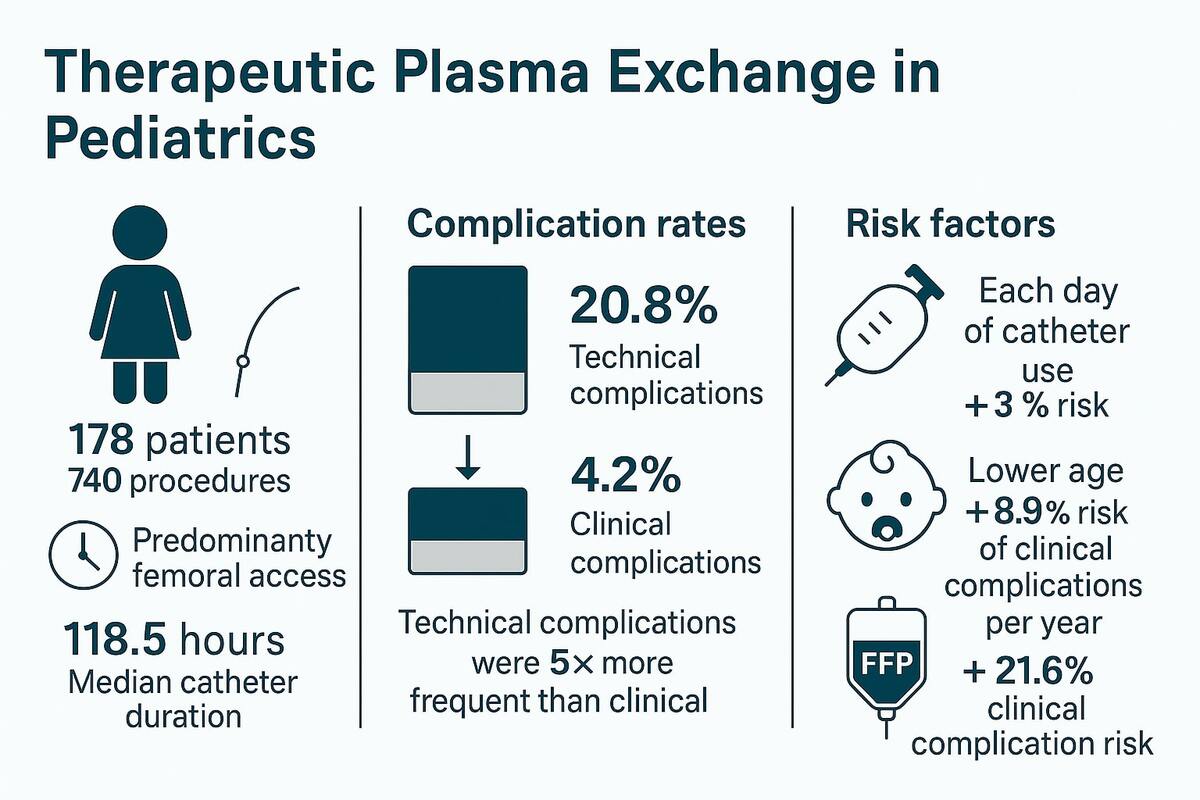Current issue
Archive
Manuscripts accepted
About the Journal
Editorial office
Editorial board
Section Editors
Abstracting and indexing
Subscription
Contact
Ethical standards and procedures
Most read articles
Instructions for authors
Article Processing Charge (APC)
Regulations of paying article processing charge (APC)
NEPHROLOGY / RESEARCH PAPER
Key technical aspects and vascular access safety in membrane-based therapeutic plasma exchange for the pediatric population
1
Department of Pediatric Nephrology and Hypertension, University Children’s Hospital, Poland
2
Doctoral School of Medical and Health Sciences, Jagiellonian University Medical College, Poland
3
AGH University of Science and Technology, Faculty of Computer Science, Electronics and Telecommunications; Department of Electronics, Poland
4
Department of Pediatric Nephrology and Hypertension, Jagiellonian University Medical College, Poland
Submission date: 2025-01-07
Final revision date: 2025-06-25
Acceptance date: 2025-07-09
Online publication date: 2025-08-23
Corresponding author
Monika Miklaszewska
Department of Pediatric Nephrology and Hypertension, Jagiellonian University Medical College, Cracow, Poland
Department of Pediatric Nephrology and Hypertension, Jagiellonian University Medical College, Cracow, Poland
KEYWORDS
childrenfiltercentral catheterTherapeutic plasma exchangetechnical adverse effectsclinical adverse effects
TOPICS
ABSTRACT
Introduction:
Therapeutic plasma exchange (TPE) is a widely used extracorporeal blood purification procedure. While its principles are similar across age groups, the technical complexity and risks are heightened in pediatric patients due to unique technical considerations. This study assesses the safety regarding both technical and clinical complications of vascular access and filters of membrane technique TPE performed in a pediatric population at a single center.
Material and methods:
This retrospective cohort study reviewed charts of patients undergoing TPE at a level 3 referral center over 25 years.
Results:
The study involved 178 patients undergoing a total of 740 procedures during 214 sessions, predominantly using femoral vascular access. The median duration of the entire TPE sessions (treated as a surrogate for catheter lifespan) was 118.5 hours. Technical complications occurred in 20.8% of procedures (31.6% of events), while clinical complications occurred in 4.2% (4.7% of events). Technical complications were nearly five times more frequent than clinical complications, with technical events being 6.7 times more common. The proportion of patients experiencing clinical complications amounted to 15.2%. Logistic regression demonstrated that each additional day of catheter placement increased the probability of technical complications by 3%. Additionally, each year of patient age decreased the likelihood of clinical complications by 8.9%, while Fresh Frozen Plasma (FFP) supplementation within a session increased the probability of clinical complications by 21.6%.
Conclusions:
Prolonged catheter use increases technical events, while FFP supplementation elevates catheter-related clinical complication risk. Advancing patient age reduces the likelihood of clinical complications, underscoring age-specific safety considerations in pediatric TPE.
Therapeutic plasma exchange (TPE) is a widely used extracorporeal blood purification procedure. While its principles are similar across age groups, the technical complexity and risks are heightened in pediatric patients due to unique technical considerations. This study assesses the safety regarding both technical and clinical complications of vascular access and filters of membrane technique TPE performed in a pediatric population at a single center.
Material and methods:
This retrospective cohort study reviewed charts of patients undergoing TPE at a level 3 referral center over 25 years.
Results:
The study involved 178 patients undergoing a total of 740 procedures during 214 sessions, predominantly using femoral vascular access. The median duration of the entire TPE sessions (treated as a surrogate for catheter lifespan) was 118.5 hours. Technical complications occurred in 20.8% of procedures (31.6% of events), while clinical complications occurred in 4.2% (4.7% of events). Technical complications were nearly five times more frequent than clinical complications, with technical events being 6.7 times more common. The proportion of patients experiencing clinical complications amounted to 15.2%. Logistic regression demonstrated that each additional day of catheter placement increased the probability of technical complications by 3%. Additionally, each year of patient age decreased the likelihood of clinical complications by 8.9%, while Fresh Frozen Plasma (FFP) supplementation within a session increased the probability of clinical complications by 21.6%.
Conclusions:
Prolonged catheter use increases technical events, while FFP supplementation elevates catheter-related clinical complication risk. Advancing patient age reduces the likelihood of clinical complications, underscoring age-specific safety considerations in pediatric TPE.
Share
RELATED ARTICLE
We process personal data collected when visiting the website. The function of obtaining information about users and their behavior is carried out by voluntarily entered information in forms and saving cookies in end devices. Data, including cookies, are used to provide services, improve the user experience and to analyze the traffic in accordance with the Privacy policy. Data are also collected and processed by Google Analytics tool (more).
You can change cookies settings in your browser. Restricted use of cookies in the browser configuration may affect some functionalities of the website.
You can change cookies settings in your browser. Restricted use of cookies in the browser configuration may affect some functionalities of the website.



